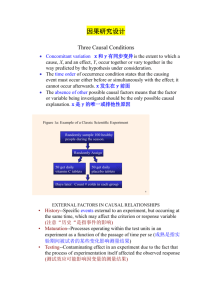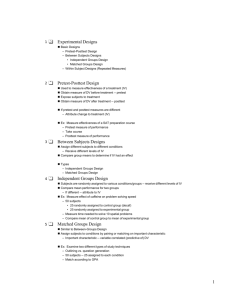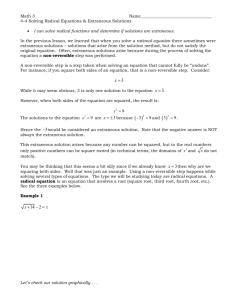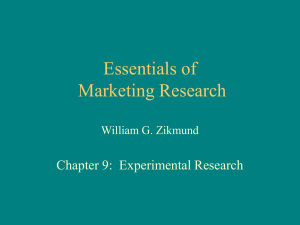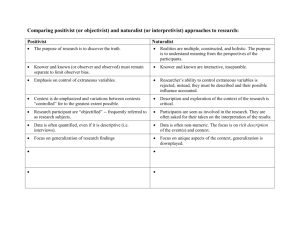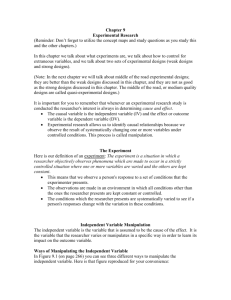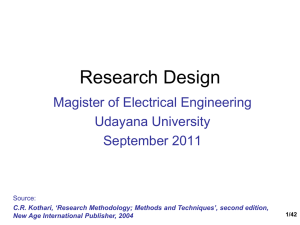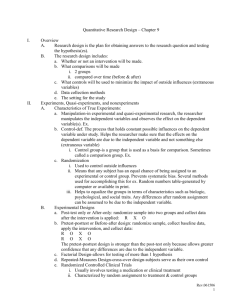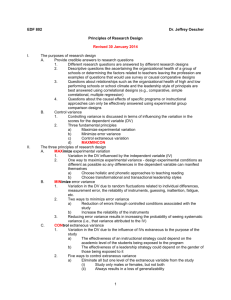MC9 - University of South Alabama
advertisement
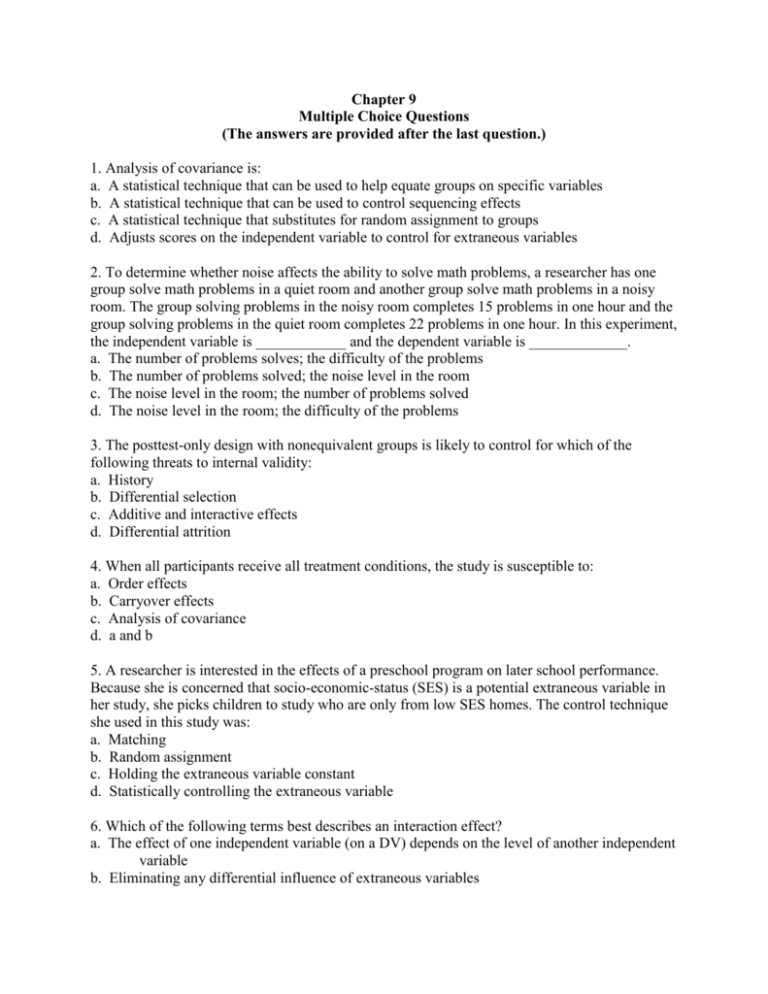
Chapter 9 Multiple Choice Questions (The answers are provided after the last question.) 1. Analysis of covariance is: a. A statistical technique that can be used to help equate groups on specific variables b. A statistical technique that can be used to control sequencing effects c. A statistical technique that substitutes for random assignment to groups d. Adjusts scores on the independent variable to control for extraneous variables 2. To determine whether noise affects the ability to solve math problems, a researcher has one group solve math problems in a quiet room and another group solve math problems in a noisy room. The group solving problems in the noisy room completes 15 problems in one hour and the group solving problems in the quiet room completes 22 problems in one hour. In this experiment, the independent variable is ____________ and the dependent variable is _____________. a. The number of problems solves; the difficulty of the problems b. The number of problems solved; the noise level in the room c. The noise level in the room; the number of problems solved d. The noise level in the room; the difficulty of the problems 3. The posttest-only design with nonequivalent groups is likely to control for which of the following threats to internal validity: a. History b. Differential selection c. Additive and interactive effects d. Differential attrition 4. When all participants receive all treatment conditions, the study is susceptible to: a. Order effects b. Carryover effects c. Analysis of covariance d. a and b 5. A researcher is interested in the effects of a preschool program on later school performance. Because she is concerned that socio-economic-status (SES) is a potential extraneous variable in her study, she picks children to study who are only from low SES homes. The control technique she used in this study was: a. Matching b. Random assignment c. Holding the extraneous variable constant d. Statistically controlling the extraneous variable 6. Which of the following terms best describes an interaction effect? a. The effect of one independent variable (on a DV) depends on the level of another independent variable b. Eliminating any differential influence of extraneous variables c. Sequencing effect that occurs from the order in which the treatment conditions are administered d. The effect of one independent variable on the dependent variable 7. Which of the following terms refers to a statistical method that can be used to statistically equate groups on a pretest or some other variable? a. Experimental control b. Differential influence c. Matching d. Analysis of covariance 8. Which of the following is not a way to manipulate an independent variable? a. Presence technique b. Amount technique c. Type technique d. Random technique 9. Which of the following designs permits a comparison of pretest scores to determine the initial equivalence of groups on the pretest before the treatment variable is introduced into the research setting. a. One-group pretest-posttest design b. Pretest-posttest control group design c. Posttest-only design with nonequivalent groups d. Both b and c 10. Counterbalancing is _________. a. Usually based on random selection of participants b. Only used when one pretest variable needs to be controlled c. Chosen to control for such things as order and carryover effects* d. All of the above 11. The group that receives the experimental treatment condition is the _____. a. Experimental group b. Control group c. Participant group d. Independent group 12. Which of the following control techniques available to the researcher controls for both known and unknown variables? a. Building the extraneous variable into the design b. Matching c. Random assignment d. Analysis of covariance 13. The group that does not receive the experimental treatment condition is the ________. a. Experimental group b. Control group c. Treatment group d. Independent group 14. There are a number of ways in which confounding extraneous variables can be controlled. Which control technique is considered to be the best? a. Random assignment b. Matching c. Counterbalancing d. None of the above 15. Which of the following could be used for randomly assigning participants to groups in an experimental study? a. Split-half (e.g., first half versus second half of a school directory) b. Even versus odd numbers c. Use a list of random numbers or a computer randomization program d. Let the researcher decide which group will be the best 16. Which term is not a related to counterbalancing? a. Carryover effect b. Order effect c. Sequencing effects d. Matching 17. A cell is a combination of two or more ____ in a factorial design. a. Research designs b. Research measurements c. Dependent variables d. Independent variables 18. Which of the following designs does an excellent job of controlling for rival hypotheses that threaten the internal validity of an experiment? a. Posttest-only design with nonequivalent groups b. Posttest-only control-group design c. Pretest-posttest control-group design d. Both b and c are excellent designs 19. Manipulating the independent variable by varying the type on the independent variable that is presented to the different comparison groups is known as _____. a. Amount technique b. Absence technique c. Type technique d. Presence technique 20. Which of the following terms is a sequencing effect that occurs from the order in which the treatment conditions are administered? a. b. c. d. Carry-over effect Order effect Sequencing effects None of the above 21. When manipulating the independent variable in an educational experiment, which of the following describes this method? a. An independent variable is manipulated using the presence or absence technique b. The researchers varies the amount of the independent variable that is administered c. The researcher varies the type of the independent variable d. All of the above are possible 22. Which method of controlling confounding extraneous variables takes precedence over all other methods? a. Matching individual participants b. Holding extraneous variables c. Building the extraneous variable into the research design d. Counterbalancing e. Randomly assign research participants to the groups 23. In an experimental research study, the primary goal is to isolate and identify the effect produced by the ____. a. Dependent variable b. Extraneous variable c. Independent variable d. Confounding variable 24. This type of design is one where all participants participate in all experimental treatment conditions. a. Factorial design b. Repeated measures design c. Replicated design d. Pretest-posttest control-group design 25. A factorial design is one in which ____. a. Only one independent variable is studied to determine its effect on the dependent variable b. Only two independent variables are simultaneously studied to determine their independent and interactive effects on the dependent variable c. Two or more independent variables are simultaneously studied to determine their independent and interactive effects on the dependent variable d. Two dependent variables are studied to determine their interactive effects 26. The design in which one group of research participants is administered a treatment and is then compared, on the dependent variable, with another group of research participants who did not receive the experimental treatment is ____. a. One-group posttest-only design b. One-group pretest-posttest design c. Posttest-only design with nonequivalent groups d. time series design 27. _____ refers to the influence of a single independent variable. a. Interaction effect b. Reactive effect c. Main effect d. Proactive effect 28. A sequencing effect that occurs when performance in one treatment condition is influenced by participation in a prior treatment condition is known as ____. a. Counterbalancing effect b. Carryover effect c. Treatment effect d. Order effect 29. Which of the following is possible in a factorial design with two independent variables? a. There is only one main effect present b. There are two main effects present c. There are two main effects and an interaction effect present d. All of the above are possible 30. Which of the following is a factorial design where different participants are randomly assigned to the levels of one independent variable but participants take all levels on another independent variable? a. One-group pretest-posttest b. Pretest-posttest control-group design c. Factorial design d. Factorial design based on a mixed model Answers: 1. a 2. c 3. a 4. d 5. c 6. a 7. d 8. d 9. b 10. c 11. a 12. c 13. b 14. a 15. c 16. d 17. d 18. d 19. c 20. b 21. d 22. e 23. c 24. b 25. c 26. c 27. c 28. b 29. d 30. d
